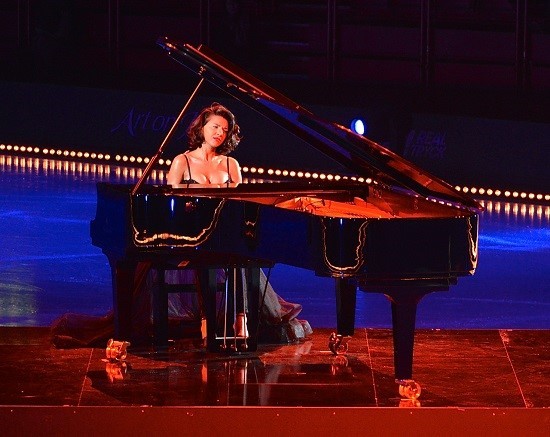Khatia Buniatishvili’s inspired interpretation of Russian composer Modest Mussorgsky’s Pictures at an Exhibition Suite for piano shows that it is perfectly possible to play classical music that has been performed countless times by the best musicians in the world, and still make a difference, bring a new sound.
اضافة اعلان
 Concert pianist Khatia Buniatishvili on the podium of Art on Ice, 2014 (Photo: Wikimedia Commons)
Concert pianist Khatia Buniatishvili on the podium of Art on Ice, 2014 (Photo: Wikimedia Commons)
The number of the truly great classical pianists alive hardly exceeds 20. If you narrow it down to those who are under the age of, say 55, the list will include even fewer than 10. Georgian-French Buniatishvili certainly belongs in this prestigious, exclusive list.
Amongst the most brilliant recordings of the 32-year-old performer is Mussorgsky’s Pictures at an Exhibition Suite. Ideally, the best way to enjoy it is by playing back the CD. This is classical music, after all, and nothing surpasses the quality of sound that an original CD would bring. The disc is titled “Kaleidoscope - Mussorgsky, Ravel, Stravinsky”.
A user review by C.T. Hatch, found on Amazon.com, reads: “I have to say that I’m a Buniatishvili junkie. Every time I hear her perform I wonder what planet she came from; she is that different.”
It is also possible to listen to the performance on audio streaming platforms like Deezer and Spotify, where the album has been available for some time and that provide good to very good sound quality.
Going to YouTube to listen to Buniatishvili play Mussorgsky is another experience altogether. Here the sound may not match that of the CD or the audio streaming platforms, but it does bring the visual impact that nicely complements the music. Seeing the musician deeply focusing on the performance, immersed in it, as if she truly were from “another planet” adds another dimension to the listening pleasure.
There are several YouTube links to the video, but I recommend looking for and watching only those that provide a 1080p High-Definition view, which can easily be checked on the settings. Other links provide only 720p, just not enough for such music.
Mussorgsky’s famous Suite includes very contrasting parts, technically speaking. From the slow, soft-tuned and recurrent Promenade to the thunderous Baba Yaga, Pictures at an Exhibition enables the pianist to exhibit a wide array of skills, different sensitivity moods and levels, and an immense scope of musical expressions. Buniatishvili excels every time.
The gentle Promenade may appear easy to play because of the slow tempo and the few notes, but it truly requires a great pianist to convey all the spirit of the piece. Musicians know how difficult it may be to play slow pieces with all the talent and expression that they often require.
Mussorgsky’s Suite is meant as a series of short pieces depicting the visit of a person at an art exhibition, and illustrating with music the different feelings of that person while strolling quietly from one painting to another, stopping before each paintings. The piece Promenade is the link between the different pieces.
There are exquisite melodic lines (The Old Castle), energetic ones (The Gnome), as well the new harmonies that were introduced by the composers from the end of the 19th century and that seemed quite daring back then.
Buniatishvili sails through all the 16 short pieces with elegance and assurance. She leaves her personal imprint on them without doubt. She emphasizes the slow passages by playing them very, very slowly, and energizes the stronger ones with really loud, powerful block chords. A few critics have found that personal imprint too obvious, but overall, most critics and listeners are just delighted to hear an interpretation that has strong character.
Pictures at an Exhibition is an essential element in the classical repertoire. Over the last 20 to 40 years, it has become a must, a reference work. It may not be as widely known as Mozart’s 40th Symphony, Bizet’s Carmen opera, or Strauss’ The Blue Danube, to name only these three as examples, but it should be part of any classical music collection.
Those interested in knowing more about it, and exploring more of it through a different perspective, can listen to the also popular orchestral version of the piano Suite by French composer Maurice Ravel. At the other end of the spectrum, the very brave only, should listen to the epic, live and turbo-charged rock performance by the British super group of the 1970s, Emerson, Lake and Palmer.
Still, the favorite version of this writer is, without hesitation, Buniatishvili’s.
Jean-Claude Elias is a computer engineer and a classically trained pianist and guitarist. He has been regularly writing IT articles, reviewing music albums, and covering concerts for more than 30 years.
Read more Opinion and Analysis







